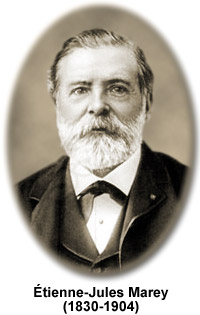Étienne-Jules Marey
(1830-1904)

Étienne-Jules Marey was born in Beaune, France on March 5, 1830 to a wine merchant and a teacher. To satisfy his father’s wishes, he decided to study medicine, attending the Faculty of Medicine in Paris. Marey’s fascination with both animals and mechanics inspired him to concentrate on physiology, and it was during his investigations of this field that he became involved in optics.
Due to a personal opposition to vivisection, Marey was inspired to find new ways to study subjects. Since his primary interest lay in developing an understanding of the motion of bodies, Marey invented a number of devices that could record movements. His initial graphic methods enabled him to examine the way humans and horses walk, as well as how birds fly. Limitations to the techniques, however, motivated Marey to consider different approaches and he was intrigued by the possibility of adapting the nascent photography methods of the period to meet the needs of his scientific research. At the time, Eadweard Muybridge had already begun his photographic experiments involving horses in motion, and when Marey saw his images in the journal La Nature in 1879, he began a correspondence with the photographer.
Marey asked Muybridge to apply his technique to the flight of birds, but was unsatisfied by the results that he obtained. Some of the most questionable aspects that Marey found in Muybridge’s work involved his basic setup, which consisted of a series of cameras that were placed parallel and adjacent to the subject’s path of movement. Marey realized that the use of a different camera to record each image meant that there was no single point of reference from which changes in position could be assessed. Moreover, accurately measuring the gaps of time between movements was problematic and, therefore, the representation of motion that was achieved was incomplete. Over the next twenty years Marey carried out a series of efforts to correct these perceived shortcomings and to make the photography of motion a more scientific endeavor.
By 1881, Marey was a professor at the College de France and was provided enough funding to establish a laboratory dedicated to physiological research. In this new setting, he developed a variety of investigative methods, the most basic of which involved recording multiple images of a subject’s motions on a single camera plate. Over time he refined this technique and was capable of taking 12 pictures per second using a photographic "gun", which looked similar to a rifle and is commonly considered the first movie camera. Following the release of improved photographic film by George Eastman in 1885, Marey was able to vastly increase the photographic gun's exposure speed to 60 images per second, greatly improving the quality of his motion pictures and essentially laying the foundations of modern cinematography.
